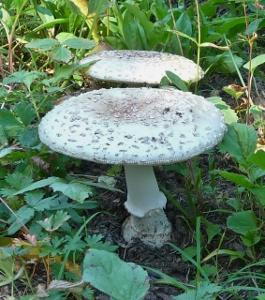Mushroom Toxicity in Dogs
- posted: Oct. 09, 2015

Fatal Fungus
Just last week I saw a story online that Dwayne “The Rock” Johnson lost one of his French Bulldogs to liver failure after the dog had eaten a mushroom in his yard. Johnson was quoted after the incident as saying, “I encourage all of you out there to be mindful of mushrooms in your yards, parks or anywhere outside your dogs play. What looks innocent can be deadly to your lil’ family members.” The Rock gives good advice.
While the white button and other edible mushrooms we buy at the grocery store are not usually a problem, wild mushrooms are often toxic to dogs (and to people for that matter.) With damp weather, mushrooms often grow in yards and area parks during the spring and fall. Our recent rains make it prime mushroom weather. There are many species of mushrooms that grow throughout the United States that can be toxic if ingested. Amanita species (death cap or destroying angel) are one of the most common, and several species of these highly toxic fungi grow in Pennsylvania. Some mushrooms cause only mild symptoms like vomiting and diarrhea but others can cause lethargy, anxious or aggressive behavior, seizures, irreversible liver damage and death depending on the type of toxin present. Wild mushrooms should be considered very dangerous. Symptoms may not occur until 10-12 hours after ingestion. Many mushrooms look very similar in appearance, so identification of toxic vs. edible varieties can be tricky.
If you think your dog has eaten a mushroom, treat it as an emergency and seek immediate medical care. Rapid decontamination of the patient by inducing vomiting or sedating the patient and “pumping” his or her stomach to remove the stomach contents, giving activated charcoal and placing the patient on IV fluids and other supportive care as soon as possible can increase the chance of recovery. Bring a sample of the mushroom with you if possible. Your pet will also likely have blood tests done to check liver function.
If mushrooms grow in areas where your pet may have access to them, try to remove them from the yard or prevent access unless you are absolutely certain they are a non-toxic species. Remember, if you see your pet eat any wild mushroom, err on the side of caution and seek immediate medical attention. Sadly, Mr. Johnson’s dog, Brutus was not so lucky, even with proper care. Having your dog seen as soon as possible may make the difference between a happy vs. a tragic ending.
This blog brought to you by the Patton Veterinary Hospital serving Red Lion, York and the surrounding areas. Comments or questions welcome on our website or Facebook page.
Location
Patton Veterinary Hospital
425 E Broadway
Red Lion, PA 17356
